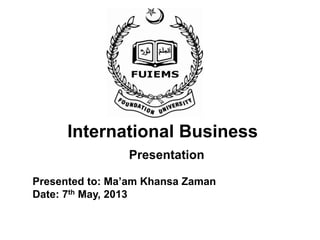International Business
- 1. International Business Presentation Presented to: Maâam Khansa Zaman Date: 7th May, 2013
- 2. Topic: Firm Heterogeneity, Exporting and FDI Group Members: 1- Umar Farooq Ali 2- Bilal Ahmed Hashmi 3- Tayyab Ali Baig
- 3. âIf two persons share 100$ each, they will only have 100$ with both of them. But if two persons share one good thought, they both will have two good thoughts each â
- 4. Executive Summary âĒ Importance of international trade. âĒ Productivity uncertainty. âĒ Firm âs Entry/exit. âĒ Relations between productivity, exporting and FDI âĒ Future predictions.
- 5. Introduction âĒ Aim of research To understand the 2 dimensions 1. Cross-border trade 2. Cross-border investment âĒ Problem statement â How changes to the cost of exporting or foreign direct investment(FDI) changes production patterns within industries and across countriesâ. âĒ Rationale of research The underlying concept behind this study was to see how productivity of a firm decides whether to export or not. A combination of sunk cost and heterogeneity is the underlying characteristics. âĒ Types of research: qualitative or quantitative This research is basically qualitative because of being constructive, naturalistic and interpretive.
- 6. Literature review âĒ Main theme regarding variables This article is divided in 5 sections having variables which shows different relations. In section 2, the relation between productivity (DV) and exchange rate, agglomeration and changed policy environment (IVâs) are discussed. In section 3, the relation between productivity (DV) and exporting and establishing production facilities overseas (IVâs) are discussed. âĒ Theory building of variable This theory was triggered by empirical observation of Bernard and Jensen (1995). Later on Melitz (2003), helpman (2004) provided different ways to think upon firm heterogeneity and participation in international markets.
- 7. Literature review (cont.) âĒ Research model
- 8. Methodology In this article, the methodology used is the same as in the past conducted researches and studies based on which this theory is generated. Some of the tests used to find the desired results are listed as follows. âĒ KS test of stochastic dominance. âĒ OLS. âĒ Matched D-I-D. These methodologies by different researchers with different samples were used around the globe in different time periods of 20th century.
- 11. Conclusion âĒ Firms who exports are more productive. âĒ Both firms (exporters and non-exporters) co-exist in the same environment. âĒ Direct linkage between production and exporting. âĒ FDI also plays role in the increase productivity on the principle of cross-border investment.











